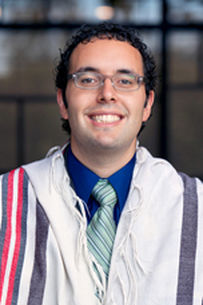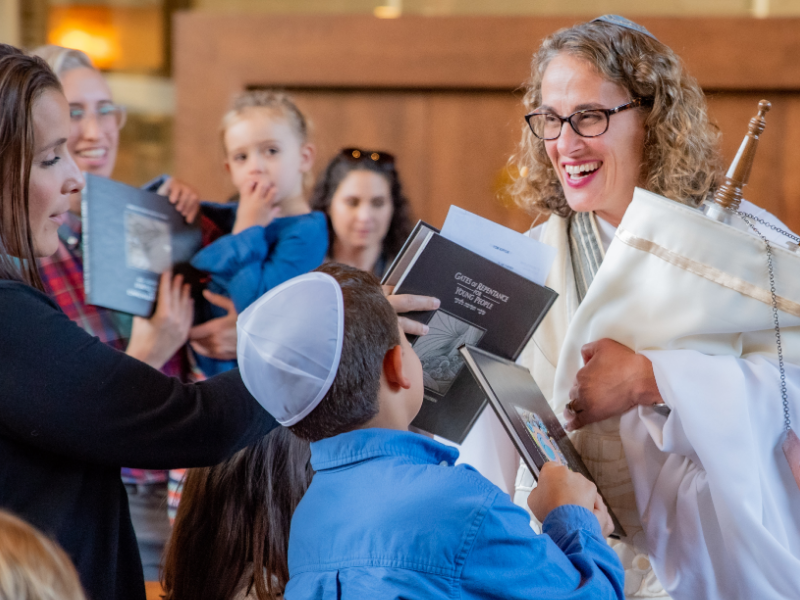 I’ve never had great knees, but this was a bit much. At 32 years old, I was limping around, struggling to go up and down stairs, and just feeling terrible about it. On Shabbat, walking the Torah around the sanctuary became a challenge, and there was no way to hide it. People noticed. Suddenly, no matter how beautiful my singing or insightful my Torah, the first thing people wanted to talk about was my knees. Even worse, I found myself obsessing about them and ignoring just about everything else. In some crazy way, I became my bad knees. Thankfully, surgery and physical therapy helped and I have long since recovered. The most important lesson I learned from my bad knees is one that I see reflected in this week’s Torah portion.
I’ve never had great knees, but this was a bit much. At 32 years old, I was limping around, struggling to go up and down stairs, and just feeling terrible about it. On Shabbat, walking the Torah around the sanctuary became a challenge, and there was no way to hide it. People noticed. Suddenly, no matter how beautiful my singing or insightful my Torah, the first thing people wanted to talk about was my knees. Even worse, I found myself obsessing about them and ignoring just about everything else. In some crazy way, I became my bad knees. Thankfully, surgery and physical therapy helped and I have long since recovered. The most important lesson I learned from my bad knees is one that I see reflected in this week’s Torah portion.
Parashat Tazria-M’tzora teaches us about our physicality; its focus is on the skin, hair, fluids, and organs that make up our bodies. We learn how out of our control those things can be and we gain some insight into our relationships with those entrusted with our care.
Famously focused on skin afflictions, this parashah describes, in explicit and sometimes grotesque detail, the procedures for when a person appears to have tzaraat, an ailment that was mistranslated as leprosy for many years. Over and over, the Torah repeats that in the midst of whatever is happening to the skin, the priest will come to see the affliction. This word “to see” (ra-ah, in Hebrew), comes up nine times in one form or another in just the first eight verses of Leviticus, chapter 13. Throughout the generations, Sages and commentators have noticed that some of these “seeings” seem to be extra. Since no word in the Torah can ever be superfluous, they have imaginatively come up with different interpretations that extend our understandings of sight.
The Sifra, an early midrashic work on Leviticus, understands the extra instance of seeing at the end of Leviticus 13:3 (“the priest shall examine the affection ... when the priest sees it”) to mean that the priest sees “the whole person as one” (Sifra Tazria 2:8). While the Sifra’s original intention for this statement was quite technical in nature, our understanding of it need not be. While inspecting the skin eruptions and other maladies the Torah describes, the priests, who we usually associate with Temple service, seem to be acting like doctors. They are responsible for proper diagnosis, for continuing evaluation throughout the healing process, and for enforcement of quarantine to contain further contagion. I have always imagined, on top of those duties specified explicitly in the Torah, that they also served a direct role in healing the afflicted. Viewing the priest as a doctor, I hear the Sifra reminding each kohein (priest) to look beyond the rashes and skin eruptions, and see the whole person as one.
We are, each of us, so much more than our afflictions. When we are seen in the right way, this Torah teaches, we can overcome the transactional nature of medical care and find the sacred at every stage of illness and the hopeful return to health.
In 1964, Abraham Joshua Heschel delivered a paper entitled “The Patient as a Person” at the annual convention of the American Medical Association. Published later as a chapter in an incredible book called, “The Insecurity of Freedom, Essays on Human Existence.” this remarkable (and brief) statement of principles for healthcare reminds both patients and doctors that they need to “see” each other:
“The doctor is not simply a dispenser of drugs, a computer that speaks. In treating a patient [they are] morally involved. What transpires between doctor and patient is more than a commercial transaction, more than a professional relationship between a specimen of the human species and a member of the American Medical Association. Medicine is not simply merchandise, and the relationship between doctor and patient is blasphemously distorted when conceived primarily in terms of economics: the doctor a merchant, the patient a consumer. What comes to pass in the doctor’s office is a profoundly human association, involving concern, trust, responsibility.” (“The Patient as a Person,” in “The Insecurity of Freedom: Essays on Human Existence” [NY: Farrar, Straus and Giroux, 1966], p. 31)
Too often, patients and doctors fail to see each other as “whole people.” We too quickly descend into what Martin Buber called “I-It” relationships; into something, in Heschel’s terms, that is “blasphemously distorted” from the sacred potential of an authentic human moment between a healer and one in need of healing. When medicine is just one more transaction in our life, no different from buying dish detergent, then neither doctor nor patient can see each other.
Seeing, our Torah teaches, can be a way to reaffirm a person’s humanity, but there is also a way of looking that directs all attention to the afflictions that plague us. If, rather than seeing a whole person, I see only legs in a wheelchair, the cancer I heard a rumor about, or perhaps some kind of rash or other skin affliction, I’m missing a lot. Those things are there and are real — but the rest of the person is not less real. We must recommit ourselves to the priestly way of seeing which, while acknowledging and sometimes helping with whatever the malady, also restores humanity.
Heschel concluded his paper with a harsh assertion that is perhaps even more true today than it was in 1964: “Eclipse of sensitivity is the mark of our age. Callousness expands at the rate of nuclear energy, while moral sensitivity subsides” (ibid., p. 37). In Parashat Tazria-M’tzora there are hundreds of chances for the priest to stare, gape, and gawk at the human body in its frailness and vulnerability. In our daily lives, each of us encounter this even more. To respond instead with true sight, with moral sensitivity, takes active commitment and conscious effort. “The calling and conduct of the doctor is care for others, and the meeting of doctor and patient is a supreme occasion for being human” (ibid. pp. 37-38) writes Heschel. When I became my bad knees, I felt profoundly less human. We are, all of us, healers, and we are, all of us, in need of healing. May our encounters, our opportunities to “see” each other, be, like the priest’s visits in the Torah, supreme occasions for being human together.
 In Tazria/M’tzora, we learn that the priests have the additional role of monitoring the healing of people and houses afflicted with an ailment called tzaraat. Earlier in Leviticus, we read how priests were expected to be above reproach, so much so, that they had to make daily atonement for themselves (Lev. 6:13). We can only hope that this act of contrition helped to keep the priests — leaders with lofty roles in the community — humble in the fulfillment of their duties.
In Tazria/M’tzora, we learn that the priests have the additional role of monitoring the healing of people and houses afflicted with an ailment called tzaraat. Earlier in Leviticus, we read how priests were expected to be above reproach, so much so, that they had to make daily atonement for themselves (Lev. 6:13). We can only hope that this act of contrition helped to keep the priests — leaders with lofty roles in the community — humble in the fulfillment of their duties.
Today, we all face the daily threat of the coronavirus. When I walk my dog in the morning, I meet the street cleaner, broom in hand and, at best, partially protected from infection. A few meters away, I see a doctor rushing to her shift at the hospital. In my rare visits to the supermarket, I meet the cashiers; they are worried about contagion but do not stop providing service and trying hard to shorten the queues.
What I see on my walks are people in essential — but not always prestigious — jobs who are dedicated to performing their tasks for others, even if it puts them at risk. With that in mind, I would like to dedicate this beautiful legend to all the people who are endangering their lives for our sake. The legend tells of the special personality of Abba the Bloodletter (Abba Umana) so-named because of his profession:
Abba the Bloodletter would receive greetings from Heaven every day; Abaye (the Sage) would receive these greetings every Shabbat eve and Rava (another Sage) would receive greetings only once a year on the eve of Yom Kippur. Abaye was distressed because he did not understand why the bloodletter received a greater honor than he did. They would say to him: You are unable to perform what he does. (see Babylonian Talmud, Taanit 21b)
Three heroes stand at the gates of our legend; two famous Babylonian Sages, and Abba the Bloodletter, who was thought to be loved more by heaven than the other two, as he received blessings from heaven every day. From the story of Cain and Abel to the days of Babylonian scholars, God has been grading us, making sure that the marks we receive are never the same yet are visible to all. And we humans compare and are envious.
Why does a bloodletter get more heavenly love than the other two? And if God favors the bloodletter over the others, why wouldn’t they too become bloodletters? I admire the answer the legend gives to Abaye's jealousy: "You are unable to perform what he does." The legend gives little credit to free choice and feelings of guilt, as it highlights ability rather than choice. A scholar can be a scholar and a bloodletter can be a bloodletter. Everyone is supposed to do what suits them, even though not all actions receive the same heavenly appreciation.
So, what was the secret to the bloodletter’s greatness? The story continues:
When he would perform a matter of bloodletting, he would bring in men and women separately. And he had a special garment that had a slit where the bloodletting instrument was inserted. When a woman came to him, he would have her dress in that garment, so he would not see her exposed. And he had a hidden place where customers would put coins to pay him — the one who had money would throw it there, while the one who did not have money would not be embarrassed. When a Torah scholar came to Abba he would take no pay from him. And after the scholar arose, Abba would give him money and say to him: “Go purchase food to heal yourself." (ibid.)
Modesty, modesty, and again modesty. This is different from our concept of modesty today. Abba the Bloodletter’s modesty is an internal attitude — the absence of condescension toward his patients.
By this stage in the story, we are convinced that the ancient doctor, Abba the Bloodletter, is such a spiritual creature that God would certainly love him more than the Sages, whose teachings were their art. But even if we are convinced, Abaye was not. Abaye plots to reveal a scam behind Abba the Bloodletter’s good name:
"One day, Abaye sent a pair of Sages to investigate him. Abba the Bloodletter sat them down, and gave them food and drink. And at night he spread out mats for them to sleep on. In the morning, the Sages rolled up the rugs, took them, and went to the market. And when Abba found them, the Sages said to him: “Let the Master appraise these rugs: How much are they worth?” He said to them: such and such. They said to him: “But perhaps they are worth more.” He said to them: “This is what I paid for them.” They said to him: “The rugs are yours and we took them from you.”
The Sages said to him: “Please tell us, of what did you suspect us?” He said to them: “I said a ransom of prisoners became available for the Sages, but they were embarrassed to ask for money.” The Sages said to him: “Now let the Master take back the rugs.” He said to them: “I put them out of my mind and consigned them for charity." (see Babylonian Talmud, Taanit 21b-22a).
Jealousy is so painful and blinding that Abaye prefers to believe that God was wrong, and did not know the true nature of Abba the Bloodletter. Abaye is willing to believe that he and his disciples could reveal through trickery what God had failed to reveal. Jealousy makes Abaye doubt the credibility of God from whom he wants to get high marks.
Thus, Abaye sends two Sages to test Abba the Bloodletter. They take advantage of Abba's kindness and receive his generous hospitality. The next day they steal the rugs they slept in and "innocently" show Abba the Bloodletter the goods, to see if he suspects them of theft.
Abba is kind and compassionate, but that doesn't make him stupid. The students examine him in his comfort zone, in the field of modesty and generosity, and there is no chance that he will fall into their trap. “Yes,” he replied, innocently, ”I thought you took the bedding because you were in dire need of money for the redemption of prisoners.” When the Sages want to return Abba’s bedding, he, in his wisdom, refuses to accept it, leaving them with the evidence of the disgraceful test they performed.
It seems to me that Abba tells the Sages who visited his house: “You need redemption.” He sends them to the beit midrash with his blankets and wishes them to find a warm and soft place to rest, away from the competitiveness in which they are trapped, and where they can find comfort and trust in other people. In this terrible time of coronavirus, let us emulate Abba, by thanking those on the frontlines who perform selfless deeds of kindness, and by respecting and valuing our fellow human beings.
Tazria/M’tzora, Leviticus 12:1-15:33
The Torah: A Modern Commentary, pp. 826-854; Revised Edition, pp. 734-764
The Torah: A Women’s Commentary, pp. 637-678
Haftarah for Rosh Chodesh, Isa. 66:1-13, 23; for Tazria/M’tzora, II Kings 7:3-20;
The Torah: A Modern Commentary, pp. 1,684-1,686; 994-996; Revised Edition, pp. 1,492-1,494; 765-767
Explore Jewish Life and Get Inspired
Subscribe for Emails


